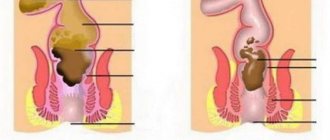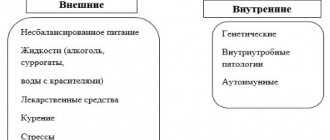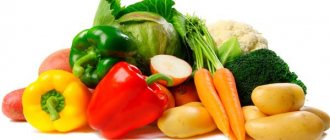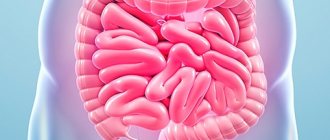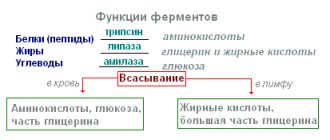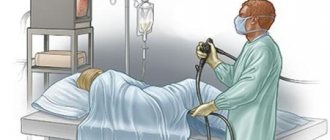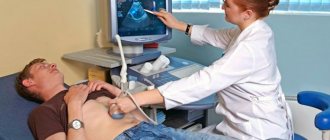The human intestine is one of the most important organs, performing many necessary functions for the normal functioning of the body. Knowing the structure diagram, location of the organ and understanding how the intestines work will help you navigate in the event of first aid, initially diagnose the problem and more clearly perceive information about diseases of the gastrointestinal tract.
A diagram of the human intestine in pictures with inscriptions on the front will make it possible to clearly and easily:
- learn everything about the intestines;
- understand where this organ is located;
- study all sections and structural features of the intestines.
What is the intestine, anatomy
The intestines are one of the most important human organs.
The intestine is the human digestive and excretory organ. The three-dimensional image clearly demonstrates the structure diagram: what the human intestine consists of and what it looks like.
It is located in the abdominal space and consists of two segments: thin and thick.
There are two sources of its blood supply:
- Thin - we supply blood from the superior mesenteric artery and the celiac trunk
- Thick - from the superior and inferior mesenteric arteries.
The starting point of the intestinal structure is the pylorus of the stomach, and it ends at the anus.
Being in constant activity, the length of the intestine in a living person is about four meters; after death, the muscles relax and provoke its increase in size to eight meters.
The intestines grow along with the human body, changing size, diameter, thickness.
So, in a newborn child, its length is about three meters, and the period of intensive growth is the age from five months to five years, when the child moves from breastfeeding to a common “table” and increased portions.
The intestine performs the following functions in the human body:
- Provides the supply of hydrochloric acid to the stomach for the primary processing of food;
- Actively participates in the digestive process, breaking down eaten foods into individual components and taking from them the microelements and water needed by the body;
- Forms and removes feces from the body;
- Has an important effect on the human hormonal and immune systems;
Gut physiology
The large intestine is a large, hollow organ of the digestive tract. It performs many important functions, while constantly being in contact with food masses. As a result, the colon is constantly exposed to various harmful factors that can cause deterioration in its functioning. Diseases of this part of the digestive system, according to medical statistics, are the most common today.
The large intestine is the last section of the gastrointestinal tract. The length of this section ranges from 1.1 to 2-2.7 meters, and the diameter reaches 5-6 cm. It is much wider than the small intestine, approximately 2.5 times. The lumen of the large intestine narrows closer to the exit from the rectum, which ends in a sphincter that allows for normal voluntary bowel movements.
Structure of the large intestine
Features of the structure of the walls of the large intestine
The walls of the colon consist of four layers:
- mucous;
- submucosal;
- muscular;
- serosa.
All these parts of the intestinal wall ensure the normal functioning of the organ and its peristalsis. Normally, the colon produces a fairly large amount of mucus, which helps move chyme through the digestive tract.
The structure of the colon wall
Attention! Chyme is a lump formed by food masses, desquamated epithelial cells, acids and enzymes. Chyme forms in the stomach, changing its consistency as it moves through the gastrointestinal tract.
Bowel functions
The large intestine ensures the completion of the movement of chyme through the digestive tract. It communicates with the external environment, which determines the specificity of its functions:
- Excretory . The main function of the large intestine. Aimed at removing various pathogens and unprocessed substances from the body. This process must occur regularly and without failures, otherwise, due to the abundance of toxins in the digestive tract, poisoning of the body develops. It is in the large intestine that stool is finally formed, which is then excreted from the rectum. The excretory function is stimulated by the next meal. After a person eats food, his brain receives a signal that increases intestinal motility and accelerates the movement of chyme towards the anus.
- Digestive . Most of the nutrients are absorbed in the small intestine, but some of the components of chyme enter the body from the large intestine: salts, amino acids, fatty acids, monosaccharides, etc.
- Protective . The large intestine contains about three kilograms of beneficial microflora, which not only ensures normal digestion, but also promotes the functioning of the immune system. Disruption of the bacterial balance leads to a decrease in the body's protective function, increased susceptibility to infectious diseases, etc.
- Suction . It is in this section of the digestive system that the bulk of the liquid is removed from the feces - more than 50%, which prevents dehydration of the body. Due to this, feces acquire a characteristic consistency and shape.
Functions of the large intestine
The large intestine has general functions, while each of its sections also performs its own tasks, determined by the peculiarities of physiology.
Sections of the colon
The large intestine has a rather complex structure and consists of several sections:
- the cecum, which has an appendage - the appendix;
- colon: ascending colon, transverse colon, descending colon, sigmoid colon;
- rectum.
Schematic representation of the sections of the large intestine
Attention! The lumens of all parts of the large intestine contain a large number of different microorganisms. They form normal intestinal microflora. Bacteria break down various components of chyme and provide the production of vitamins and enzymes. Optimal functioning of all parts of the intestine is the key to proper digestion.
Cecum
The large intestine begins with the blind section, which is localized in the right iliac region. Its shape resembles a pouch, delimited by two sphincters: the ileocecal valve separates the small intestine, and the Gerlach valve prevents digestive products from entering the appendix.
Location of the appendix
Attention! The appendix is an appendage of the cecum. Its diameter does not exceed 0.6 cm, and its length varies from 2.7 to 12-13 cm.
It is the cecum that is the site of development of the largest number of various diseases of the large intestine. This is due to both the morphological and physiological characteristics of this section. Pain in diseases of the cecum is localized in the right umbilical region or above the ilium.
Colon
The main part of the large intestine is the colon. Its length reaches 1.7 meters, and its diameter is about 5-7 cm. The colon is separated from the blind fragment of the intestine by the Busy valve.
The structure of the colon is divided into four sections:
- ascending colon;
- transverse;
- descending;
- sigma.
Location of the colon
The ascending section is not involved in the main process of food digestion, but it ensures the absorption of fluid from the chyme. It is in this fragment of the digestive tract that up to 30-50% of water is removed from the feces. The ascending colon is a continuation of the cecum, and its length varies from 11 to 20 cm. This area is located at the posterior wall of the abdominal cavity on the right. If any pathology affects the ascending intestine, then the pain syndrome is localized in the area from the ilium to the hypochondrium.
The ascending section becomes transverse, starting in the hypochondrium on the right. The length of this fragment can be from 40 to 50 cm. In the transverse intestine, liquid is also absorbed from the chyme, as well as the production of the enzyme necessary for the formation of feces. In addition, it is in this section that pathogenic microorganisms are inactivated. When the transverse section is affected, discomfort occurs in the area 2-4 cm above the navel.
Location of the transverse colon
The descending colon is about 20 cm long and is located downward from the left hypochondrium. This part of the intestine is involved in the breakdown of fiber and contributes to the further formation of feces. In the left iliac fossa the descending section becomes the sigmoid section. Sigma has a length of up to 55 cm. Due to the characteristics of the topography, pain during various pathologies of this organ can be localized both in the abdomen on the left and radiate to the lower back or sacral region.
Rectum
The rectum is the terminal, that is, the final, section of both the large intestine and the entire digestive tract. This section of the digestive tract is distinguished by its specific structure and functioning.
Rectal Information
The rectum is located in the pelvic cavity. Its length does not exceed 15-16 cm, and the distal end ends with a sphincter, which communicates with the external environment.
Attention! In this section of the intestine, the final formation and accumulation of feces occurs immediately before defecation. Due to the peculiarities of physiology, it is the rectum that is most susceptible to various mechanical damage: scratches, cracks, irritation.
Pain due to dysfunction of the rectum is localized in the perineum and anus, and can radiate to the pubic area and genitals.
Video - Three tests for intestinal diseases
Small intestine and its functions
The diagram clearly demonstrates the location of the small intestine between the stomach and large intestine.
The small intestine is responsible for the digestive process, and it is named so because of its comparatively smaller diameter and thinner walls, unlike the large intestine. But in its size it is not inferior to any organ of the gastrointestinal tract, capturing almost the entire lower space of the peritoneum and part of the pelvis.
The overall work of enzymes in the small intestine, gallbladder and pancreas promotes the breakdown of food into individual components. Here, the absorption of vitamins, nutrients, and active components of most medications necessary for the human body takes place.
In addition to digestive and absorption functions, it is responsible for:
- movement of food masses further through the intestines;
- strengthening the immune system;
- hormonal secretion.
This segment is divided according to its structure into three sections: duodenum, jejunum, and ileum.
Small intestine
The human intestine, which is called the small intestine, is divided into several sections: duodenum, jejunum, ileum.
The duodenum is the first part of the digestive chain after the stomach and gets its name from its size. The twelve fingers are the cross section of our hand. It is about thirty centimeters long and four to five in diameter, shaped like a horseshoe. The length of this section of the intestine, both in an adult and a small person, is insignificant, but its role is enormous.
Here intestinal digestion begins, pancreatic enzymes are introduced, and the composition of the incoming digestive substance is regulated. The structure of the mucosa is resistant to the action of stomach acid, bile and some enzymes.
The next section is the jejunum, which has a two-layer structure of smooth muscle. External muscles are located lengthwise, internal muscles are located across.
Thanks to this structure, contraction of the intestinal walls allows you to speed up or slow down the process of absorption of necessary substances. The composition determines the speed of progress. The length of the middle section is up to one and a half meters. Scientists have found that women's intestines are designed so that they are shorter than men's.
Most likely, this is caused by physiology; nature gave women more space, because their womb is aimed at containing the fetus inside itself. And it is precisely because of this that, despite the differences, the functionality of their organs significantly exceeds the same functions of men. The absorption area is increased due to the circular or transverse folds inherent in the next section of this organ. As in the ileum, rare enzymes called enterocytes are secreted here.
These particles break down food into simple amino acids and release them, and glucose is released from some of the fatty acids. In their pure form, fatty acids are absorbed and transported to the liver through the structure of capillaries responsible for the lymph circulation.
The structure of the ileum is similar to the previous jejunum. Only a decrease in diameter to three centimeters is noticeable, which helps to slow down the passage of the digested mixture and improve absorption. The blood supply to this section is much stronger than the previous one and the walls are a little stronger and thicker.
Small intestine function
The small intestine is designed so that it can absorb the maximum amount of nutrients from the entire digestive tract. The useful surface area, in addition to folds, is increased by fibers. They are covered with special epithelial cells that improve the absorption process.
The most important vital function is the production of neurotensin. It is he who regulates our drinking and food reflexes, that is, it signals what a person lacks.
Each compartment, like this one, has adjustable partitions that prevent the contents of individual compartments from mixing. In addition to the blood supply, there is a huge number of lymphatic and nerve endings.
The production of hormones is a special function of the tissues of this section of digestion and is considered part of the endocrine system. The main part of hormones is reproduced in the first two and insignificant in the last section of this part of the intestine.
Finale of digestion
The final section of digestion is the area of the large intestine. One and a half meters of length is not the limit, but the diameter is five to seven centimeters.
The main segment of the large intestine is the colon. It is divided into descending and ascending regions, there is a transverse region and a sigmoid part.
The appendix and cecum are also part of this last section. The rectum completes all digestive procedures by removing waste to the outside through the anus.
The large intestine does not contain villi; the muscles that make up it are smooth and longitudinal. The remaining food mass comes here. Its length is about one and a half meters. The areas of the colon make the final push to process what remains with the help of special enzymes.
The secretion of special mucus promotes better movement of internal masses. In the colon, the formation of feces is formed with further removal from the body through the anus. This is where fiber, remaining liquid and salts are absorbed.
Appendix
The appendix has long been considered a separate unnecessary area. It looks like a “blind” tank several centimeters in length. In animals, its participation was noted earlier. In humans, it was accepted as useless. But during the experiment, a group of children had it removed.
The result was a decrease in immunity.
It is now considered a breeding ground for beneficial bacteria. An undesirable consequence is surgery when this sac fills and the surrounding lymph nodes become inflamed.
The operation is simple, but if the intervention is not carried out in time, it can result in death. Surgical preparation of this appendage is leading throughout the world.
Our assistants
The human intestine contains about fifty trillion bacteria. This is more than the total number of cells in our body.
Microorganisms coexist with us mutually beneficially, help digest food, and fight against violators of the digestive flora. They are divided into two main types: anaerobes and aerobes.
Anaerobes are bacteria that extract energy without oxygen. There are also macro-level organisms included in this group.
Aerobes are organisms that require free form oxygen to produce energy. The basis of life activity is oxidative processes involving molecular oxygen.
Research by Californian scientists has shown that the bacteria in our intestines have a feedback relationship with our eating habits and vice versa, and even affect micron-level nerve endings, sending signals to our brain. Residents of the coast will find microorganisms accustomed to sea food, which will not be found among inhabitants of continental latitudes.
Keep it normal
The health of the body directly depends on maintaining the intestines at the proper level. The products we consume are directly proportional to the proper functioning of this important organ.
Environmental pollution, poisoning from alcohol and tobacco products, abuse of antibiotics, use of antibacterial agents, consumption of large amounts of sugar and carbohydrates cause a negative shift in normal intestinal function. Stress can also cause the disorder.
Adjusting your diet will help normalize the microflora. Fruits and vegetables rich in fiber and pectin, whole grain products, fermented milk products - all this will help cope with a number of disorders.
Food should be varied and include proteins and fats of plant and animal origin. It is better to eat small portions and drink more clean water. The length of the intestines of any person includes processing departments, in a clear sequence, of a technologically precise digestive plant.
Let's summarize
The freshness of the food consumed should be given special attention. Pathogenic bacteria are found in the same huge quantities in the external environment and not all of them can be dealt with by our internal helpers.
It is very easy to get poisoned and the total length of the intestine, with all its protective functions, will not save you.
The stomach of some people can digest nails, but there are a number of bacteria and toxic substances of plant and man-made origin that not only unsettle you for some time, but will cause serious illnesses, cancer, and can even lead to death. This will never happen if you are attentive to yourself and your loved ones.
Beneficial physical activity will not be superfluous, since with the work of muscles and ligaments all metabolic processes are enhanced, mood improves and the desire for life increases, which we all sometimes lack.
duodenum
The beginning of the structure of the small intestine opens - the duodenum, stretching behind the pylorus of the stomach, fitting the head and partly the body of the pancreas, thereby forming the shape of a “horseshoe” or semi-ring and flows into the jejunum.
Consists of four parts:
- Upper;
- Descending;
- Lower;
- Rising.
In the middle of the descending part, at the end of the longitudinal fold of the mucous layer, there is the nipple of Vater, which includes the sphincter of Oddi. The flow of bile and digestive juice into the duodenum is regulated by this sphincter, and it is also responsible for preventing the penetration of its contents into the bile and pancreatic ducts.
Where is the large intestine located and what does it look like (with photo)
The anatomy of the large intestine differs from the structure of the small intestine.
Even the appearance of these two organs makes it possible to unmistakably distinguish them from each other, not to mention their size. The large intestine is wider, but much shorter, which does not detract at all, but does not in any way exalt its functional significance: the length reaches no more than 2 m, and the width varies in the initial (up to 7 cm) and final (up to 4 cm) sections.
To understand what the large intestine looks like, imagine a corrugated pipe.
Just like it, the large intestine has typical swellings, which are delimited from each other by fairly deep grooves located transversely, as well as by longitudinal bands formed by muscles. There are three such tapes in total.
Their origin is found at the base of the appendix, and they extend all the way to the rectum. It is precisely due to the difference between the length of the ribbons and the intestinal sections between them that the above swellings are formed, which scientists call “haustra”.
The location of the large intestine is such that it covers, figuratively speaking, two “floors” of the body at once: the pelvis and the abdominal cavity.
This organ is notable for the fact that it receives undigested food debris, which is affected by various bacteria living in the intestine.
This is also where some of the water and minerals are absorbed. Ultimately, the lumen of the organ is filled with waste, and feces are formed.
The passage between the small intestine and the thick part is an opening characterized by narrowness and the appearance of a slit and located almost horizontally. In this place there is a special valve in the form of a funnel, with its narrowed end facing the colon. This arrangement prevents content from moving backwards.
Anatomy: parts of the large intestine
In anatomy, it is customary to distinguish the following parts of the large intestine: the blind part is the initial and widest section, which has the so-called vermiform appendix, better known as the appendix; the colon, which has four sections - the ascending section, the transverse section, the descending and sigmoid sections; and finally, the rectum is the final section ending with the anus (anus).
The part where the large intestine begins, where the appendix is located, is called the cecum.
It passes directly into the ascending colon, going all the way to the liver, and then turning and reaching in the form of a transverse colon to the spleen, where it rushes down, called the descending part of the organ and passes into the sigmoid. The latter, bending in the form of a loop, descends into the small pelvis, where the rectum originates.
It is an undeniable fact that it is very helpful to better understand and visualize where the large intestine is located, the photo and drawing of its location below:
If you carefully study these images, it becomes obvious that the organ in question has points of contact with many organs of the abdominal cavity or is located close to them. This is very important to remember, because... inflammation of these organs can spread to the intestines and vice versa.
This article has been read 38,482 times.
Each organ of the digestive system performs its own function, and the saturation of the body with the substances necessary for normal life depends on their coordinated work...
The microflora of the small and large intestines is a group of microorganisms in the gastrointestinal tract that lives in close interaction with the host. Both humans and intestinal flora are in symbiosis, ...
Not only a person’s weight, but also the overall health of the body depends on the proper functioning of the gastrointestinal tract. If all the main functions of the gastrointestinal tract are performed clearly, without...
Nephrologists identify eleven functions of the kidneys in the body, and this article discusses in detail the eight main ones. In addition, you will learn about the structure of the nephron of the kidney,...
There are ten main functions of the liver, and each of them is very important for the body. It is this largest gland of all vertebrates that neutralizes toxins, and in the fetus it performs...
The exocrine function of the pancreas is provided by the exocrine glands. This article will discuss the mechanism of emulsification and hydrolysis...
The main function of the human digestive system is to digest food. After thermal and chemical treatment, the breakdown products are absorbed into the blood and lymph, ...
Speaking about the features of the skeletal system of a newborn, the structure and functional differences of the musculoskeletal system and the skull are considered separately. Besides...
The digestive system of a newborn baby has a number of differences from the digestive tract of an adult. We are talking about the degree of development of the gastrointestinal tract, and about...
Teenagers get a general idea of the genital organs of men and women in high school. Practice shows that, without encountering problems in this area, ...
What do you know about the anatomy of the oral cavity, teeth and their functions? You can bet that unless you are a dentist, your knowledge is limited to a list of basic names...
When we say “bilious temperament” or “bilious character,” we mean that a person, to put it mildly, is not very pleasant to talk to. This is explained by the fact that the composition of bile...
One of the main places in the biliary tract system is occupied by the gallbladder, an unpaired organ that serves as a kind of “storage” for bile secreted by the liver. ...
The structure of the human peripheral nervous system is no less highly organized than the structure of the central nervous system. The development of a number of diseases is associated with damage to the PNS...
The main functions of the central nervous system, along with the peripheral one, which is part of the general human nervous system, are conductive, reflexive and controlling. Highest...
The structure of the nervous system is based on nerves and neurons. It is studied by several scientific disciplines, including neuroanatomy, neurophysiology, molecular...
The body’s ability to work, its endurance, beautiful posture and gait largely depend on how strong a person’s spinal column is. In addition, the functions...
Being part of the human endocrine system, the hypothalamus and pituitary gland closely interact. With the direct participation of the hypothalamus, special substances are produced ...
Source: https://med-pomosh.com/?p=1251
Skinny
Next in the order of the human intestinal structure diagram is the jejunum. It is separated from the duodenum by the duodenojejunal sphincter, located in the peritoneum at the top left and smoothly flows into the ileum.
The anatomical structure separating the jejunum and ileum is weakly manifested, but there is still a difference. The ileum, relatively lean, is larger in diameter and has thicker walls. It was called skinny due to the absence of contents in it during the autopsy. The length of the jejunum can reach 180 cm; in men it is longer than in women.
Loose bowels
Weak gut is an umbrella term to describe many different gut symptoms. It is usually associated with constipation and is therefore described as weak stools. Despite the tension, the person has great difficulty in defecating. Weak intestinal muscles are also called weak bowel, but it is a condition in which there is fecal incontinence. In this condition, the ability to hold a bowel movement is often due to weakness in the pelvic floor muscles.
Constipation and bowel incontinence are two different conditions. Therefore, the term "weak gut" may not be an accurate term to describe these conditions. However, the basic meaning is much the same - it indicates muscle weakness. In constipation, this weakness may be related to the muscles of the intestinal wall, while in fecal incontinence, the weakness occurs in the pelvic floor muscles.
Weak gut is an umbrella term to describe many different gut symptoms
Colon
The lower and last segment of the gastrointestinal tract and intestines is the large intestine, which is responsible for the absorption of water and the formation of feces from chyme. The figure shows the location of this section of the intestine: in the abdominal space and the pelvic cavity.
The structural features of the wall of the colon consist of a mucous layer that protects from the inside from the negative effects of digestive enzymes, mechanical injury from solid particles of feces and simplifies its movement to the exit. Human desires are not subject to the work of the intestinal muscles; it is absolutely independent and not controlled by man.
The structure of the intestine starts from the ileocecal valve and ends with the anus. Like the small intestine, it has three anatomical segments with the following names: cecum, colon and rectum.
Structure of the intestinal wall
The intestinal wall consists of four membranes.
- Mucous.
- Submucosa.
- Muscular.
- Serous.
Mucous membrane. Divided into three layers:
- the surface layer of cells is the epithelium;
- lamina propria;
- muscle part.
The structure of the mucous membrane depends on the section of the intestine. In the small intestine, on the surface of the epithelium there are villi - small protrusions that increase the area of absorption of nutrients. There are no villi in the large intestine; there are crypts - large deposits of mucous membrane.
Submucosa. It contains a large number of vessels and nerves that ensure the normal functioning of the intestines. There are also glands that synthesize hormonal substances. They regulate the digestion process.
Be sure to read:
Preparation and performance of intestinal sigmoidoscopy
Muscular membrane. The third shell is formed by muscle fibers. It includes one circular (circular) layer and one longitudinal layer.
Serous membrane. The outer membrane - serous - is part of the peritoneum covering the intestines. It forms several processes - omentums, which contain a large amount of fatty tissue.
Blind
The initial section of the human large intestine, located according to the scheme in the right iliac fossa, framed everywhere by the peritoneum, is arranged in the shape of a pouch.
From the posterior wall of the cecum stands out its appendage, nothing more than the appendix, a tubular appendage about ten cm in size and one cm in diameter, which performs secondary functions necessary for the human body: it produces amylase, lipase and hormones involved in the work of intestinal sphincters and peristalsis.
The unobvious connection between the brain and the gut: how it affects health
The human body is amazing. Even the most resilient people with nerves of steel can be outwardly calm, but experience a feeling of stomach cramping or knotting from stress. This sensation is based on the work of a huge network of neurons located in the intestines.
The network of neurons in the gut is so extensive that it is often called the “second brain” or the enteric nervous system. It consists of interconnected nerve ganglia in the intestinal wall and contains more than 100,000,000 neurons, 1 which exceeds the number in the spinal cord.
The enteric nervous system, like the brain, uses about 30 biologically active chemicals to transmit information between cells; 90% of the body's serotonin is located in the intestines 2. Serotonin is one of the chemical messengers through which nerve cells “communicate” with each other; it serves as a “transmitter” in the interaction between the intestines and the brain, as well as a regulator of intestinal motility. Thus, the intestinal and central nervous systems are similar in structure and function and are in constant interaction 1 .
Colon
The main part of the large intestine is located according to the structure between the cecum and rectum.
At the junction with the cecum, the cecal ascending sphincter is located. The colon is divided into the following segments:
- Ascending;
- Transverse;
- Falling;
- Sigmoid.
Here, water and electrolytes are absorbed in large quantities, as well as the transformation of liquid chyme into hardened, formed feces.
Weak motor skills
Decreased motility leads to infrequent and insufficient bowel movements. Chronic constipation appears.
Symptoms
- defecation less than once every 3 days;
- small amounts of hard feces;
- the need to strain hard during bowel movements;
- aching pain in the abdomen;
- bloating;
- decreased appetite;
- irritability, drowsiness.
Be sure to read: Buckthorn-based laxatives: list of drugs and their use
Causes
- An unbalanced diet - lack of plant fiber, excess carbohydrates, pureed food, poor drinking regime.
- Physical inactivity . With a sedentary lifestyle, smooth muscle tone decreases.
- Pregnancy . The hormone progesterone relaxes smooth muscles. 50% of women suffer from constipation during pregnancy.
- Elderly age . More than 60% of people over 65 years old have problems with bowel movements. With age, the sensitivity of intestinal wall receptors decreases, and the function of nerve cells that regulate motility is impaired.
- Heredity . The tendency to intestinal atony is inherited. If parents suffer from constipation, the likelihood of problems with bowel movements in children reaches 52%.
- Side effects of drugs . Intestinal motility is inhibited by iron supplements, antidepressants, antispasmodics, and antiulcer drugs.
- Irritable bowel syndrome with a tendency to constipation is a functional disease of the digestive tract associated with a violation of autonomic regulation. Main signs: abdominal pain and stool disorders.
- Chronic diseases : scleroderma, hypothyroidism, diabetes.
Straight
Located within the pelvis and without torsions, the rectum completes the structure of the large intestine, starting from the sigmoid colon (level of the third sacral vertebra) and ending with the anus (perineal area). This is where stool accumulates, controlled by the two sphincters of the anus (internal and external). A cross-sectional diagram of the intestine demonstrates its division into two sections: narrow (anal canal) and wide (ampullary section).
Nervous system of the intestine - why is it needed?
The “second brain” is not the birthplace of conscious thought or decision making. Philosophy and poetry are left to the brain, but the function of the enteric nervous system is no less important. It has long been known to control digestion 1 . The breakdown of food, the absorption of nutrients, and the removal of undigested particles require proper rhythmic muscle contractions that move food evenly down the gastrointestinal tract. And the nervous system regulates complex intestinal motility.
The intestinal system is connected through the vagus nerve to the brain. Most of the vagus nerve fibers carry information from the gut to the brain 1 . This means that everyday emotional states can affect the gut. When your stomach cramps or “bear sickness” takes you by surprise, this may be an example of the manifestation of such a physiological reaction to acute stress.
Parameters and diseases of the intestines
| Intestines and its parts | Parameters (cm) | Diseases | |
| Length | Diameter | ||
| Small intestine | 350-400 | Proximal 4-6, distal 2-3. | Obstruction, ciliacia, enteritis, colitis, Meckel's diverticulum. |
| duodenum | 21-25 | 42859 | Duodenitis, ulcer |
| Skinny | 90-180 | Jeunit, ulcer, | |
| Ileum | 130-260 | 2.7 | Crohn's disease, terminal ileitis. |
| Colon | 150-200 | 42951 | Atony, cancer, inflammation. |
| Blind | 3-8,5 | 7 | Cancer, appendicitis. |
| Colon | About 150 | From 5 -8 | IBS, aganglionosis, regional enteritis, colitis, constipation and diarrhea, intussusception. |
| Straight | 14-18 | 4-7,5 | Cancer, hemorrhoids. |
The general health of a person depends on the normal functioning of the intestines. This organ is susceptible to various disorders, disorders and inflammations, often due to human fault due to errors in nutrition. Serious pathologies are also no exception - to prevent their development and exacerbation, it is recommended to monitor your health, undergo unscheduled examinations, and lead a healthy lifestyle.
Reducing intestinal motility
Diet
Nutrition during accelerated peristalsis should be gentle. Eliminate fatty, fried, spicy, rough foods. Eat small portions up to 6 times a day. For diarrhea, prepare pureed dishes: casseroles, puddings, soufflés, purees. The basis of the diet should be foods with a fixing effect.
Grocery list
- potato;
- rice and semolina;
- pasta;
- jelly;
- berries: blueberries, chokeberries, bird cherry;
- pomegranate;
- three-day kefir.
Drugs
- Loperamide - reduces the tone of intestinal smooth muscles and inhibits motor activity. The drug is prescribed for the symptomatic treatment of diarrhea of non-infectious origin.
- Antispasmodics - relieve intestinal spasms and abdominal pain, do not inhibit normal motor skills. Preparations: Mebeverine, No-shpa, Papaverine hydrochloride.
- Enzyme preparations are products containing pancreatic enzymes. Improve digestion and absorption of food, reduce the volume of intestinal contents. Indirectly affect peristalsis. Popular medications: Mezim-forte, Creon, Panzinorm.
Impaired intestinal motility may have physiological causes or be one of the symptoms of a digestive tract disease. If you have a long-term bowel disorder, be sure to consult a gastroenterologist.
In continuation of the topic, be sure to read:
- Details about the coprogram: preparation, conduct and interpretation of the analysis
- Rectal fissure: causes, symptoms and treatment of pathology
- Irritable bowel syndrome: symptoms and treatments
- Causes of bloating and increased gas formation, treatment methods
- Rectal cancer: symptoms, stages, treatment and prognosis for life
- Intestinal dyskinesia: types, causes, symptoms and treatment methods
- Causes of abdominal pain: pathological and non-pathological cases
- Details about bowel cancer: stages, symptoms, treatment and prognosis
- Intestinal inflammation: signs of pathology, use of diet and drugs for treatment
- Peristalsis: concept, norm and pathology
Intestinal atony: what is it and how does it occur?
This is a decrease in the tone of the intestinal muscles, in which their ability to contract decreases or completely disappears.
As a result, the functionality of the intestines decreases: food is still digested and useful components are absorbed, but the movement of food through the intestines is difficult. As a result, fecal stagnation and constipation occur. This leads to the accumulation of waste and fecal stones.
Stagnation of undigested food is a rather serious problem.
Firstly, fermentation begins in the intestines, which is accompanied by the release of a large amount of gases and irritation of the mucous membrane. Secondly, irritation of the mucous membrane by toxins and bacterial activity cause inflammation (slight inflammation occurs already on the 2-3rd day of irregular bowel movements), which becomes chronic over time. Thirdly, the components formed as a result of fermentation and rotting of food are partially absorbed into the blood, causing general intoxication of the body.
Normally, the intestinal muscles contract approximately 18 times per minute. With atony, the number of contractions decreases to several units per minute, in the worst case, disappears altogether.
Small intestine
This section of the gastrointestinal tract got its name due to its small diameter, which varies from 2.5 to 6 cm. The structure of the walls differs between the mucous membrane and the submucosa, the muscular layer, and the outer serous membrane. It can be compared with the width of the lumen of the colon - from 6 to 10 cm. If the structure of the intestine is presented in good quality pictures, then the differences are better visible.
In addition to its own glands located in the wall of the department, ducts open into its lumen through which pancreatic juice and bile flow. Anatomically, the size of the duodenum is small (finger is the ancient name for a finger). However, this department is very important for changing food.
- Pancreatic juice entering the duodenum is necessary for the digestion of carbohydrates, proteins and lipids. The composition of the juice is greatly influenced by the type of food eaten. Thus, when consuming large amounts of fat, the lipase content is higher. If proteins predominate, then the concentration of enzymes that break them down is higher.
- Lipase, which breaks down fats, is activated in the presence of bile. It “breaks” fats into tiny droplets, making them more accessible to enzymes. Trypsin and chymotrypsin are involved in the decomposition of protein molecules.
- The absorption of amino acids, simple sugars, and vitamins begins in the walls of the duodenum. The transition of molecules from food to lymph and blood continues in the jejunum. The length of this section is 0.9–2 m. The walls are relatively thick and well supplied with blood.
Diseases of the small and large intestine in men, women, children: symptoms, causes, treatment
Manifestations caused by intestinal diseases are a sensitive topic; sick people are reluctant to consult a doctor. But in vain, because problems in the early stages, as a rule, are more successfully treated. At the same time, advanced diseases can have dangerous consequences.
Causes
Intestinal pathologies are caused by factors of different nature.
Intestinal diseases often arise from a complex of reasons, including:
- genetic predisposition,
- maintaining a lifestyle with little physical activity,
- exposure to stress
- bacterial and viral intestinal infections,
- immunological disorders,
- smoking and other bad habits,
- as a result of taking certain medications, this effect can primarily be caused by long-term use of antibiotics;
- incorrectly composed diet.
First signs
Symptoms indicating intestinal problems:
- rumbling,
- stool disorders,
- pain in the intestinal area.
List
The intestine is an organ that has a length of several meters and two main compartments:
- small intestine,
- colon.
The last department, in turn, consists of many departments. Depending on the location of the inflammatory processes, the disease is called:
- sigmoiditis – the problem is in the sigmoid colon,
- ileitis - the same in the ileum,
- colitis - the same in the colon,
- proctitis - the same in the rectum,
- appendicitis - the same in the appendix,
- jeunitis - the same as jejunum,
- typhlitis - the same as the cecum,
- enteritis - the same as the small intestine,
- duodenitis - the same as the small and duodenal intestines.
The small intestine is responsible for feeding our body at the cellular level. The main disorder or deterioration that occurs with pathology of the small intestine is a weakening of absorption functions.
Diseases of the small intestine manifest themselves through the following signs:
- rumbling in the intestinal area,
- frequent loose stools without mucus or blood; characteristic components of feces in diseases of the small intestine are the remains of undigested food;
- pain in the navel area or on the right side of the abdomen,
- bloating.
The disease is an inflammation of the intestinal mucosa. Due to inflammatory processes, the ability to absorb nutrients changes for the worse. Functional disorder leads to a state of intolerance to certain foods.
The disease is manifested by the formation of an eosinophilic infiltrate in the intestinal walls. Indicates itself with a variety of symptoms and has a tendency to relapse.
Possible consequences of the disease:
- a higher than normal content of neutral fats (steatorrhea) is detected in the stool,
- insufficient presence of iron in the blood (anemia).
Pathology is provoked by:
- pet parasite,
- helminthic infestations,
- food allergy,
- intestinal obstruction.
Whipple syndrome
The disease is infectious in nature. Damage occurs to the lymphatic system located in the small intestine. The defeat consists of blockage of the system elements by mucopolysaccharide bacterial complexes.
Main manifestations:
- steatorrhea,
- severe diarrhea,
- anemia,
- significant weight loss.
The disease is based on a disorder in the function of lipid metabolism. The pathology is a rare occurrence. Metabolic disorders associated with the absorption of fats lead to severe weight loss.
Small bowel cancer
Tumors of a malignant nature are rare in the small intestine. Among formations in the gastrointestinal tract, cancerous tumors of the small intestine account for one percent.
Malignant tumors are formed from pathologically altered cells of the small intestine. The progression of pathology leads to the spread of tumors to neighboring organs.
The problem is difficult to determine because the symptoms of the disease coincide with the main signs of pathology of the small intestine. More often, tumors in the early stages are discovered during surgery.
The large intestine has the function of absorbing certain substances, as well as removing the remains of processed food from the body.
Problems of this organ indicate discomfort in the lower abdomen. Symptoms of the problem are similar to common symptoms of bowel disease.
- rumbling in the abdominal area,
- pain is felt in the anus, pain symptoms are often observed in the lateral parts of the organ;
- bloating,
- but when stool disorders occur, namely diarrhea, blood and mucus are observed in the discharge;
- there may be mucus discharge from the anus,
- a person experiences fecal incontinence.
The disease has general symptoms:
- exhaustion,
- lack of strength,
- sexual desire disorder.
A common disorder that indicates that the intestines are working with motility problems, which leads to various difficulties in moving food.
This may occur due to the following factors:
- psychogenic disorders,
- wrong diet
- endocrine diseases,
- functional disorders in the work of other digestive organs.
Symptoms are mostly characteristic of intestinal disease:
- rumbling,
- stool disorder,
- bloating,
- pain in the intestinal area.
The disease is a process where sinuses appear on the intestines. Diverticula are protrusions on the surface of the large intestine. This is caused by the weakness of the walls and the willingness to form such protrusions.
The disease code according to ICD 10 is designated K57.
The symptoms coincide with the general signs of intestinal disease. It’s just that bowel dysfunction manifests itself in a tendency to constipation. With this disease, it is important to choose the right diet.
The disease can lead to complications:
- the appearance of an inflammatory tumor,
- perforation in places where the wall bulges can provoke peritonitis.
Chronic colitis
The inflammatory process of the intestinal mucosa is called chronic colitis. Pathology leads to various changes in the intestinal wall.
Symptoms:
- rumbling,
- flatulence,
- sharp cramps in the abdomen after eating,
- bowel dysfunction is inconsistent: there may be constipation, and then it is replaced by diarrhea;
- poor health,
- there is a bitterness in the mouth,
- loss of appetite.
The disorder is caused by an immune malfunction. Why it appears, experts have not yet found an answer.
With this pathology, the intestinal walls are affected by an inflammatory process, which also has the characteristic of diffuse and ulcerative.
The disease manifests itself with symptoms:
- The stool is often loose, although there may be constipation,
- bleeding,
- general malaise,
- pain in the intestinal area.
Pathology causes consequences:
- perforation of the intestinal wall,
- bleeding,
- colon cancer,
- polyps.
Colon cancer
The tumor arises on the surface of the mucosa and spreads along the lining wall. The disease has a share of five percent in the total number of cancer diseases.
Pathology is often a consequence of neglected and untreated intestinal diseases. The onset of the disease is typical in old age and occurs more often in men.
Common signs of intestinal disease include:
- constipation,
- there is blood in the stool,
- emaciation,
- general malaise.
The tumor is treated by surgical removal, otherwise the prognosis is poor.
A group of intestinal diseases is called general pathologies because they are characterized by a specific disease of the walls or part of the intestine.
Crohn's syndrome
Inflammation spreads to all layers of the intestine. In addition, the affected intestine is only part of the diseased organs. In the chronic course of the disease, the pathological process covers both the esophagus and the stomach.
In the intestine there are places with a narrowed lumen. The mucous surface and the intestinal lymphatic system are affected.
Leads to consequences:
- elevated temperature,
- fistula formation,
- skin rashes,
- deterioration of liver function,
- decreased vision,
- joint damage.
The pathology is associated with vascular disease in the intestinal walls. As a result, their narrowing may occur, organ tissues do not receive additional nutrition, and oxygen starvation may occur.
Symptoms:
- pain in the abdomen,
- blood spots in the stool,
- general malaise,
- nausea,
- accelerated peristalsis.
The consequences of pathology may appear:
- thrombus in a vessel of the intestinal wall,
- insufficient nutrition or its complete absence in certain areas contributes to tissue death,
- intestinal dysfunction.
Adhesive process
Adhesions occur as a result of:
- long-term inflammatory process in the intestinal walls,
- complications after surgery,
- ischemia of organ tissue.
Symptoms of pathology that will complement the general symptoms characteristic of intestinal disease:
- deterioration of stool movement and intestinal release,
- signs of intestinal dysfunction due to necrosis of its individual sections.
The sphincter is responsible for regulating the process of excretion of feces. There are a wide variety of reasons that can initiate a disruption in its work.
Signs of the disease:
- severe pain during defecation,
- the presence of blood in the stool,
- false urges,
- pain can radiate to neighboring organs. Timely treatment has a good prognosis.
In children
In childhood, there are deviations in intestinal health that are characteristic of this period.
Syndromes:
- exudative enteropathy,
- insufficient digestion,
- insufficient absorption.
Diseases are defects that appear as a result of insufficient or abnormal development of an organ, including during the prenatal period:
- intestinal duplication
- anorectal anomalies, intestinal stenosis;
- intestinal rotation is a developmental anomaly;
- congenital megacolon.
Functional diseases include:
- spastic colitis,
- irritable bowel syndrome.
It is important to obtain a complete understanding of the disease, its location, and the nature of the lesion.
To do this, research is carried out:
- Capsule endoscopy makes it possible, among other things, to detect Crohn's disease;
- Colonoscopy allows you to look at all parts of the intestine;
- magnetic resonance imaging - detailed and high-quality diagnosis of the organ;
- upper endoscopy allows you to examine the small intestine;
- X-rays can determine pathological parameters.
Treatment methods
Help in detecting the disease can be medicinal. Experts prescribe the following medications:
- immunostimulants,
- anti-inflammatory,
- agent drugs capable of modifying the disease,
- antibacterial.
Diagnosis of atony
To make a diagnosis of intestinal atony, laboratory and instrumental studies are used:
- stool analysis for bacterial culture;
- colonoscopy with biopsy (visual examination by inserting a colonoscope camera into the rectum and taking a piece of mucous membrane for analysis);
- X-ray (helps to exclude obstruction, as well as determine the presence and size of fecal stones).
Treatment tactics depend on the causes of the disease and the degree of muscle tone impairment.
Rectum
At the end of the large intestine there is another section - the rectum. Through it, feces accumulate, form and are expelled. The exit from the rectum is located in the pelvic area and ends at the anus. The length of the human intestine in this lead ranges from 13 to 23 centimeters, and in diameter from 2.5 to 7.5 centimeters.
The rectum, despite its small size, consists of several sections:
- supramullary;
- rectal ampulla;
- perineal section;
- anal columns;
- internal, then external sphincter;
- anal sinuses and valves.
Duodenum
The duodenum is one of the shortest sections, but it is not the least important in the entire digestive system. The length of the human intestine in this section is about 21-25 centimeters. It is here that the incoming food is broken down into its components: carbohydrates, proteins and fats. The duodenum is also responsible for controlling the release of the required amount of hydrochloric acid that enters the stomach and helps break down food into smaller fragments. Through the production of various enzymes and the flow of bile, it sends signals to the rest of the intestines to begin moving food from the stomach, facilitating the beginning of the release of secretions for further processing of chyme.
Intestinal atony - what is it?
Intestinal atony is a violation of the tone of the intestinal walls, as a result of which they cannot contract and relax normally to push feces to the rectum and subsequent exit. With atony, intestinal motility (the contractility of the muscles of the walls of the gastrointestinal tract) is disrupted, which leads to constipation in humans, difficulty or impossibility of excreting feces. In summary, atony is not constipation, but a dysfunction of intestinal motility, which leads to stagnation of feces.
How to identify and treat intestinal atony
Constipation is a disease caused by intestinal atony. Many patients do not pay due attention to constipation, citing the fact that it can go away on its own, and are embarrassed to consult a doctor on such an “intimate” issue. In fact, fecal retention in the intestines can have a very negative impact on the general condition of the patient, leading to intoxication, the appearance of inflammatory processes, and even the need for surgery.
Pain in the intestines in the lower abdomen - causes of inflammation of the stomach, symptoms of diseases, how to treat intestines
All systems of the human body are interconnected and depend on each other for proper functioning. When pain occurs in the lower abdomen, it can be provoked by several organs at once. People often complain that their intestines hurt in the lower abdomen. You need to understand what paroxysmal, throbbing, bursting, cutting pain means, and what to do with it.
There are many organs in the lower part of the human torso. Each of them can cause pain. , the primary task in treatment is to determine the source of inflammation. They can be:
- stomach;
- appendix;
- intestines;
- reproductive organs or genitourinary system;
- spleen.
More often, sharp painful attacks are caused by irritable bowel syndrome; cutting discomfort has varying degrees of intensity (from mild to acute), often becoming stronger after eating. The disease is accompanied by the following symptoms:
- feeling of incomplete bowel movement;
- bloating;
- constipation;
- flatulence;
- diarrhea;
- “lump in throat” when swallowing;
- muscle pain;
- nausea.
Cramping pain in the lower abdomen
Such sensations are usually caused by obstruction of the colon. It may occur due to a failure in the movement of its contents through the intestines. The main symptom will be cramping pain, bloating, and less commonly:
- vomit;
- loss of appetite;
- absence, stool retention.
Contractions usually occur every 15 minutes. If you do not pay attention to these symptoms, then after 3 days they will disappear, but this should alert the patient even more. Such changes may indicate a cessation of intestinal motility, which can lead to intoxication and death. In such a situation, immediately consult a doctor at the hospital.
In most cases, inflamed appendicitis creates discomfort in the right side. Initially, the pain is spread throughout the stomach area in the middle, but later it appears in the lower abdomen and is concentrated on the right.
The pain intensifies when turning over from one side to the other, walking or coughing. Over time, tension will arise below, which is an important signal to go to the hospital.
The person will constantly feel sick, the temperature and blood pressure will rise, there will be an appetite disorder, and loose stools.
Pain in the intestines on the lower left side
Often people, when meeting with a doctor, say that they have pain in the left lower abdomen. This localization of discomfort may indicate a number of diseases:
- Irritable bowel syndrome. The cause of the disease is unclear, but many argue that stress causes it. It appears in men and girls of any age, but is more common in women over 30. Pain in the intestines on the lower left side is chronic and can be accompanied by constipation, flatulence, and diarrhea.
- Crohn's disease can cause pain in the left lower abdomen. This is an inflammatory process of the gastrointestinal tract that occurs in the descending colon.
- Hirschsprung's disease. This is a hereditary pathology that boys are more susceptible to. The disease is characterized by the absence of areas of innervation in limited, individual areas of the large intestine.
If discomfort occurs in the lower part of the body, it is important to determine the nature of the pain and symptoms in order to properly treat the disease.
Depending on the root cause, the doctor may prescribe one or another remedy. No less important is the provoking factor (cause), which caused a dull, pulling, cutting pain below.
As a rule, it lies in the intestines, which ceases to function properly:
- Overeating food. If, an hour after eating, along with a feeling of oversaturation and unpleasant belching, pain appears in the intestines in the lower abdomen, this indicates a weakness in the digestive process. This happens due to low acidity, the stomach does not have enough gastric juice, which leads to incomplete digestion of food, which over time begins to ferment and cause discomfort.
- Sometimes the intestines in the lower abdomen hurt from stress. This is possible in the presence of constant irritation factors that provoke the occurrence of ulcerative colitis. Pain in the intestines in the lower abdomen is dull, aching, and sometimes radiates to the left side. Symptoms of the disease include false urge to defecate, blood in the stool, fever, diarrhea, and general weakness.
- Pain in the rectum and lower abdomen during menstruation is associated with an increase in blood flow to the pelvis. This can provoke stagnation in girls who are predisposed to the development of varicose veins. This occurs with decreased vascular tone and severe weakness of connective tissue. Congestion is characterized by nagging unpleasant sensations, pain during bowel movements, protrusion of hemorrhoids, and constipation.
- Some pathologies are characterized by pain in the intestines in the lower abdomen. These, for example, include diverticulitis, which occurs when there is inflammation in the areas of protrusion of the colon. Unpleasant sensations occur when feces and food stagnate in these areas. Intestinal pathology also includes the appearance of tumor formations. These could be polyps (benign) or colon cancer. At the very beginning, the sensations are not very pronounced, but after growth the neoplasm blocks the lumen and symptoms of intestinal obstruction occur (colic, stabbing pain, constipation).
What to do if there is pain in the lower abdomen
If you feel chronic, regular colic in the lower abdomen, aching pain, sharp cramps, then with such problems you need to contact a gastroenterologist who will conduct the necessary tests and examinations.
For one-time manifestations of the disease, you can take medications that improve the functioning of the stomach and intestines. Antispasmodics help well with cramping pain; it is better to take tablets containing enzymes before/after meals.
There are general recommendations that will help avoid the need for treatment:
- You should not frequently take laxatives or do enemas.
- Add more foods that contain fiber to your diet. If you experience flatulence after taking them, try replacing them with nutritional supplements.
- If you use a laxative, change the drug periodically so as not to cause your body to become addicted to a particular medicine.
- Doctors recommend adding foods containing pectin (most citrus fruits) to your diet.
- To improve peristalsis (pushing mass), it is recommended to drink more water.
- Eliminate coffee, hot peppers and other hot seasonings from the menu that irritate the mucous membranes of the gastrointestinal tract, and stick to your diet.
How to diagnose pain in the intestines in the lower abdomen
If the cutting pain in the lower abdomen lasts more than 3 days, home medication therapy does not lead to the desired result, you need to consult a doctor who can accurately determine the causes of these sensations and prescribe an adequate course of therapy. To determine the source, the following diagnostic methods are used:
- Visual inspection. The specialist assesses the patient’s condition based on external signs.
- Palpation. This palpation technique helps determine the degree of inflammation, location, nature and intensity.
- Ultrasound. Ultrasound examination provides the opportunity to obtain the most complete information about the condition of all parts of the intestine.
- Colonoscopy. A special device that is used only to study the condition of the colon.
What treatment is needed if the lower abdomen hurts severely?
When the pain is chronic and occurs regularly, you need to consult a specialist and conduct a study. Most people prefer to relieve spasms and pain on their own without seeing a doctor. To reduce discomfort in the intestines, drugs that can relieve pain are more often used:
- antispasmodics;
- analgesics;
- anti-inflammatory medications.
When a person suffers from diarrhea, it is necessary to take antidiarrheal medications. These can be medications or folk remedies (decoctions, infusions).
For constipation, you need drugs from the group of laxatives; preference should be given to options that increase not only peristalsis, but also improve the condition of the gastrointestinal microflora.
Strictly follow the dosage for adults and children indicated on the package.
In many cases, a person manages to cope with abdominal pain on his own, but there are certain accompanying symptoms for which an ambulance should be called:
- temperature rises to 39;
- the person is unable to sleep or do any other activities;
- diarrhea with bright red blood;
- vomiting blood;
- stomach hard as a board;
- loss of creation due to pain;
- Along with diarrhea and vomiting, severe dehydration is observed.
: why does it hurt in the lower abdomen
Source: https://sovets.net/6578-boli-v-kishechnike-vnizu-zhivota-.html
Parasites in the intestines
An intestinal infection is yersiniosis, which is caused by the bacteria Yersinia. Infection occurs by eating contaminated foods. The pathogen enters the gastrointestinal tract, where it causes an inflammatory process. Symptoms of the disease are similar to gastroenteritis, acute appendicitis, and hepatitis. Taking antibiotics Gentamicin, Doxycycline; probiotics, enzymes and vitamins.
Infection with Giardia is the cause of disruption of the enzymatic and absorption functions of the small intestine. The microorganism can also live in the large intestine. To remove Giardia, take anthelmintic drugs Albendazole, Nemozol, antimicrobial agents Metronidazole, Furazolidone.
Dangerous helminths - roundworms, tapeworms, whipworms, and other representatives of round and flatworms. Ascariasis is a common helminthic disease. It mainly affects children under 9 years of age. Roundworms harm the human body in the stage of adult parasite and larvae.
Folk remedies are also used to eliminate worms: garlic, pumpkin seeds. More effective drugs for the treatment of common helminth infections: Albendazole, Mebendazole, Pyrantel, Piperazine.
Work experience more than 7 years.
Professional skills: diagnosis and treatment of diseases of the gastrointestinal tract and biliary system.
The human intestine is one of the most important organs, performing many necessary functions for the normal functioning of the body. Knowing the structure diagram, location of the organ and understanding how the intestines work will help you navigate in the event of first aid, initially diagnose the problem and more clearly perceive information about diseases of the gastrointestinal tract.
A diagram of the human intestine in pictures with inscriptions on the front will make it possible to clearly and easily:
- learn everything about the intestines;
- understand where this organ is located;
- study all sections and structural features of the intestines.
Structure of the human intestine
An organ located in the abdominal cavity, the intestine, is responsible for digestive and excretory functions in humans. The length depends on the condition and is 4–8 m. The minimum value corresponds to tonic tension - intravital. With atony, the value reaches 7–8 m.
With age, the intestinal structure, position, and shape change. The most intensive growth occurs at the age of 1–5 years.
The structure of the human small intestine
From the sphincter of the stomach - the pylorus - begins the first segment of the intestine - the small intestine. The proximal part d is 5 cm, the distal part is less, 3 cm.
Consists of 3 subdivisions:
- It starts from the duodenum. Shaped like the letter C, it is located around the head of the pancreas.
- Then comes the jejunum section - empty. It got its name due to the fact that when the body is opened, there is almost always no content in it.
- The lower part of the small intestine becomes the ileum. With its help, bile acid and vitamin B12 are absorbed.
The location of the ileum and jejunum is intraperitoneal, i.e. inside the peritoneum. They have a peritoneal fold - a mesentery - that attaches the intestine to the posterior wall of the cavity. Lymph nodes, blood vessels, nerves, and fatty tissue pass between its leaves.
The intestinal wall consists of the following subsections:
- Outer layer (serous)
- Muscular – divided into longitudinal external and circular (circular) internal
- Submucosa
- Ends with mucosa
The mucosa consists of smooth muscle, connective tissue plate, and epithelium. Its villi are covered with epithelial cells and facilitate the absorption process.
The structure of the human large intestine
Located in the lower part of the intestine, liquid is absorbed in it, food gruel is absorbed from the chyme, and feces are formed.
Shares:
- The intestine is cecum and the appendix is a worm-shaped appendage
- Colon - it includes the ascending, transverse colon, descending, sigmoid colon
- Straight - ampulla - a wide part and a narrowed tip ending in the anus.
The mucosa of the large intestine is without villi, with a large number of crypts. Longitudinal, circular smooth muscle fibers represent the muscular lining of the colon.
Physiological stages of digestion in the intestine
The digestive process begins in the small intestine. The pancreas produces enzymes. With their help, complex polymers are broken down. The resulting disaccharides and polypeptides are divided into monosaccharides, fatty acids, monoglycerides, and amino acids. The course of hydrolysis depends on intestinal enzymes.
The contents are mixed, ground and moved further due to intestinal contractions.
It has a great influence on metabolism and performs an endocrine function. Intestinal cells synthesize various hormones that regulate the functioning of body systems. Plays an important role in the formation of cellular immunity.
Bacteria contained in the intestines support the digestive process. Therefore, it is necessary to preserve and maintain normal microflora in order to avoid complications of varying severity. Take care of the health of your intestines, because the functioning of the entire human digestive system depends on it.
Source: Pichevarenie.ru
link:
Professor, Doctor of Medical Sciences Alieva Elmira Ibragimovna Diagnosis and treatment of IBD (Crohn's disease, ulcerative colitis) in children
Make an appointment
Source: https://kronkolit.pro/stroenie-kishechnika-cheloveka/

